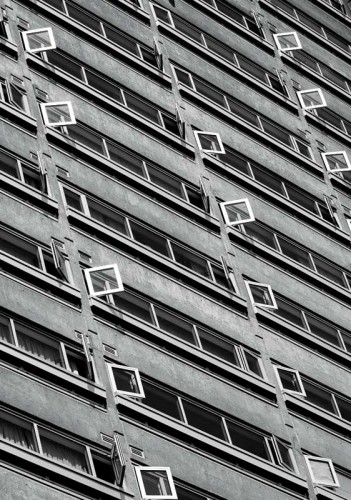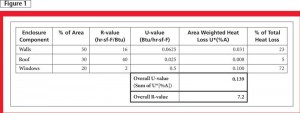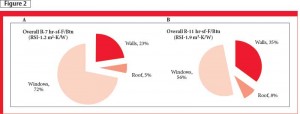Thermal importance of windows

By Brittany Hanam, MASc, EIT, Graham Finch, MASc, P.Eng., and Dave Ricketts, MSc, P.Eng.
Of all the components of a building enclosure, windows can have the greatest impact on energy consumption. This can be disproportionate to the area of the enclosure the windows cover. Therefore, it is important architects and specifiers are aware of the significant impact of windows on the overall building enclosure’s thermal performance when designing, evaluating, and selecting enclosure assemblies for new buildings and retrofit projects. The examples in this article focus on residential buildings, but the discussion generally applies to most facility types.
Understanding the thermal performance of windows
There are two properties that describe the energy performance of windows: U-value (i.e. U-factor) and solar heat gain coefficient (SHGC).
Thermal performance of windows and other building enclosure components is typically measured in terms of either U-value or R-value. The former is a measure of the overall rate of heat transfer through the entire fenestration product (or other enclosure assembly) under standardized winter conditions. While the rate of heat transfer varies through the frame, the glass edge, and the centre of glass, the U-value represents the overall rate of heat transfer through all these components. U-value is expressed in either W/m2-K or Btu/h-sf-F under standardized winter conditions and usually for a standard window unit size.
R-value is the thermal resistance of a material or assembly––in other words, its ability to resist heat transfer. The R-value is the inverse of the U-value (R = 1/U). U-values are most commonly used to describe windows, while R-values are typically used for opaque enclosure assemblies such as walls and roofs. One should always remember that for optimal thermal performance, high R-values and low U-values are good.
SHGC is the proportion of incident solar radiation transferred through the product, and is a decimal fraction between zero (totally opaque) and 1.0 (a hole in the wall). A window with a high SHGC allows more heat from the sun that hits the window to reach the inside space. A window with a low SHGC allows less solar heat incident on the window to enter the building.
Lower U-factors are always desirable as they represent less heat transfer (primarily winter heat loss) and, therefore, less energy needed for heating and cooling. The merits of increasing or decreasing the SHGC depend on building-specific design parameters. In cold climates, fenestration with high solar heat gain can reduce the need for heating in winter. In many climates, however, it is also beneficial to minimize solar heat gain in summer for comfort or to reduce the need for cooling. The optimal SHGC should be chosen based on numerous factors including climate, window orientation, and exterior shading features.
The U-factor and SHGC of a window can be determined by either Canadian Standards Association (CSA) A440.2, Energy Performance of Windows and Other Fenestration Systems, or National Fenestration Rating Council (NFRC) 100, Procedure for Determining Fenestration Product U-factors, and NFRC 200, Procedure for Determining Fenestration Product Solar Heat Gain Co-efficient and Visible Transmittance at Normal Incidence.

R-Values and U-Values in context
To put the numbers in perspective, a 38 x 140-mm (2 x 6-in.) wood frame wall with R-21 (RSI-3.7) batt insulation has an overall effective R-value of about R-16 (RSI-2.8) (loss in insulation R-value occurs due to thermal bridging of the wood studs). A steel-framed wall with continuous exterior insulation––uninterrupted by framing (i.e. not between the studs)—can achieve overall R-values of R-15 (RSI-2.6) and greater, depending on the insulation thickness. A low-slope roof with 102 mm (4 in.) of continuous insulation can achieve R-20 (RSI-3.5). (This information is according to American Society for Heating, Refrigerating, and Air-conditioning Engineers (ASHRAE) 90.1-2010, Energy Standard for Buildings Except Low-rise Residential Buildings).
Windows generally have lower R-values than opaque enclosure assemblies. Their R-values typically range from R-1 (RSI-0.2) for poor-performing products (e.g. single-glazed with an aluminum frame) to about R-6 (RSI-1.1) for a high-performance product that still uses conventional technologies (e.g. triple-glazing with a fibreglass frame and multiple low-emissivity [low-e] coatings). These R-values correspond to a high (i.e. poor) U-value of U-1 (USI-5.7) to a best U-value of 0.17 (USI-1.0). Although higher R-value products are available, they use proprietary technologies and are often cost-prohibitive for many projects.

Thermal anatomy of a building
The overall thermal performance of a building, or part of it, can be calculated by area-weighting the individual building enclosure U-values. (It is important for one to remember the area weighting calculations must be done using U-values and not R-values. The technical explanation for this is because R-values in parallel cannot be added linearly (similar to resistors in an electrical circuit). This is also why the overall R-value is not linearly related to the individual R-value components. Components with poor (i.e. low) R-values but less area can still have a great effect on the overall building R-value). For example, for a building enclosure consisting primarily of windows, walls, and roof, the overall U-value would be:
Uoverall = % windows x Uwindows + % walls x Uwalls + % roof x Uroof
The overall U-value or R-value of a building enclosure can give a quick and general idea of how the building will perform in terms of energy consumption. A building with a high R-value (i.e. low U-value) will generally have lower heating and cooling energy requirements than a building with a low R-value (i.e. high U-value). There are many other factors that contribute to a building’s energy performance, but the enclosure is generally a very important one.
For example, the following demonstrates an effective enclosure R-value calculation for a wood-framed house. Its walls, windows, and roof are in the following proportions:
- 50 per cent walls–R-16 (RSI-2.8);
- 30 per cent roof–R-40 (RSI-7.0); and
- 20 per cent windows–R-2 or U-0.5 (RSI-0.4 or USI-2.8).
Using the area-weighting formula:
Uoverall = 1/16 x 0.50 + 1/40 x 0.30 + 1/2 x 0.20 (1/2.8 x 0.50 + 1/7 x 0.30 + 1/0.4 x 0.20)
Uoverall = 0.14 = R-7 (USI-0.72 = RSI-1.4)

This calculation is also shown in Figure 1. The amount of total heat loss through each enclosure component is calculated by dividing the U*(per cent area) for each component by the total overall U-value (sum of U*per cent area). This simplified analysis ignores heat loss due to air leakage, which can be just as significant as conductive heat loss through an enclosure; however, the focus here is to relate heat loss through windows to other enclosure components.
Calculating the percentage of heat loss through each component shows that, for this scenario, 72 per cent of heat loss is through the windows, even though they only represent 20 per cent of the enclosure area. This means improving the windows, rather than the wall or roof R-values, is the best way to raise the house’s thermal performance.
This is shown graphically in Figure 2. In Figure 2a, using a window U-value of 0.5 or R-2 (USI-2.8 or RSI-0.4), 72 per cent of heat loss occurs through the windows. In Figure 2b, if the windows are improved to U-0.25 or R-4 (USI-1.4 or RSI-0.7), heat loss through the windows is reduced to 56 per cent. The R-2 (RSI-0.4) improvement in windows results in an overall enclosure R-11 (RSI-1.9)––an increase of R-4 (RSI-0.7) or 57 per cent.







